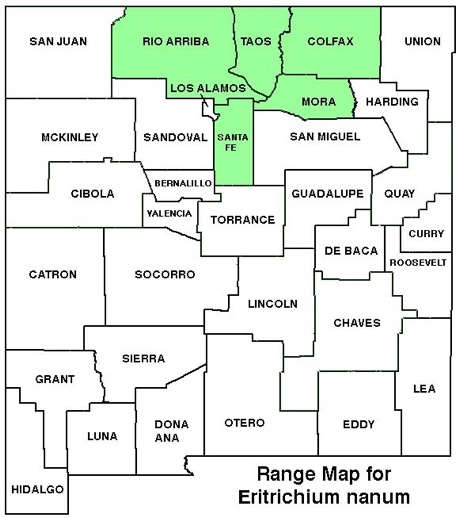WILDFLOWERS OF NEW MEXICO

Mat-forming cushions of basal leaves covered long, loose hairs have dense clusters of small but eye-catching blue flowers on stems 1/2–4-inches tall. Note the white and yellow throats. These rugged plants with delicate flowers thrive in harsh habitats above timberline, along with other low-profile flowers adapted to bitter winds, snow, and a short growing season.
FLOWER: June–August. Dense clusters of funnel-shaped blue flowers to 3/4-inch wide (20 mm); 5 spreading, rounded petal-like lobes; throat is ringed with white and yellow. The 4-inch tall flower stalk gets the seed head up into the wind to disperse the tiny seeds.
LEAVES: Basal, alternate on short stems. Blades oval, to 3/8-inch long (10 mm), thick; surfaces loose-hairy; tips pointed to blunt, often with a tuft of hair.
HABITAT: Rocky granitic soils; alpine slopes and scree-covered areas above timberline.
ELEVATION: 12,000–13,200 feet.
RANGE: AK, CO, ID, MT, NM, OR, UT, WA, WY; circumboreal from Alaska to Eurasia.
SIMILAR SPECIES: The blue flowers, cushion profile, and alpine habitat help identify this plant. It often grows in association with Alpine Phlox, Phlox condensata; Moss Campion, Silene acaulis; Rocky Mountain Clover, Trifolium attenuatum; Alpine Sandwort, Minuartia obtusiloba; Alpine Primrose, Primula nanum.
NM COUNTIES: Northern NM in high-elevation, rocky habitats above timberline: Colfax, Mora, Rio Arriba, Santa Fe, Taos.

ALPINE FORGET-ME-NOT
ERITRICHIUM NANUM
Borage Family, Boraginaceae
Perennial herb



THE CONTENTS OF THIS WEBSITE ARE COPYRIGHTED AND CANNOT BE USED
WITHOUT PERMISSION OF GEORGE OXFORD MILLER
EMAIL ME

Long, loose hairs cover the dense basal (right arrow) and oval alternate stem (left arrow) leaves.


Alpine Forget-Me-Not often grows imbedded in or associated with other mat-forming tundra plants, such as Alpine Phlox, Phlox condensata.
